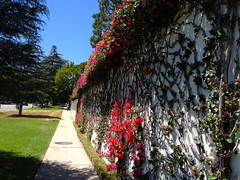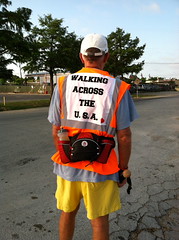Checking in from Van Nuys, Los Angeles, CA …
 Over the last two days, I walked from Pasadena through Los Felix and Hollywood to Beverly Hills ending just some 7.5 miles short of the finish line of this fantastic journey. That last leg will take place on Sunday, September 2, ending at the Santa Monica Pier. Some members of our family and some of our friends will either walk with me or be at the finish line to celebrate with Brenda and me. Many others, who have been with us in spirit, will be in our thoughts as the final of an estimated 5.6 million steps are completed.
Over the last two days, I walked from Pasadena through Los Felix and Hollywood to Beverly Hills ending just some 7.5 miles short of the finish line of this fantastic journey. That last leg will take place on Sunday, September 2, ending at the Santa Monica Pier. Some members of our family and some of our friends will either walk with me or be at the finish line to celebrate with Brenda and me. Many others, who have been with us in spirit, will be in our thoughts as the final of an estimated 5.6 million steps are completed.
 A press release from the LA American Heart Association (AHA) had invited the media to meet with me in Pasadena at the Colorado Street Bridge. This is a beautiful 99 year old concrete arch bridge that spans Arroyo Seco and connects Pasadena to the towns of Eagle Rock and Glendale. It is on the National Historic Register and is beloved for its Beaux Arts arches, light standards and railings. Locals know it with the unfortunate moniker of the “Suicide Bridge” since almost 100 people have jumped from this structure over the years.
A press release from the LA American Heart Association (AHA) had invited the media to meet with me in Pasadena at the Colorado Street Bridge. This is a beautiful 99 year old concrete arch bridge that spans Arroyo Seco and connects Pasadena to the towns of Eagle Rock and Glendale. It is on the National Historic Register and is beloved for its Beaux Arts arches, light standards and railings. Locals know it with the unfortunate moniker of the “Suicide Bridge” since almost 100 people have jumped from this structure over the years.
 We were delighted that four television stations and one newspaper were there to cover and help promote my walk for heart health. (No, they didn’t come to see me jump from the bridge.) The ABC, NBC and Fox affiliates were represented and filmed interviews as did the Los Angeles local station, KDLA.
We were delighted that four television stations and one newspaper were there to cover and help promote my walk for heart health. (No, they didn’t come to see me jump from the bridge.) The ABC, NBC and Fox affiliates were represented and filmed interviews as did the Los Angeles local station, KDLA. The local newspaper, the Pasadena Star-News also sent a photographer and conducted a telephone interview. The media coverage gets our message out and helps explain the need for exercise to mitigate the risks of heart disease. It can also help encourage donations to the AHA through our website. Thanks to Kristine Kelly of the Los Angeles AHA for a great job arranging the media event.
The local newspaper, the Pasadena Star-News also sent a photographer and conducted a telephone interview. The media coverage gets our message out and helps explain the need for exercise to mitigate the risks of heart disease. It can also help encourage donations to the AHA through our website. Thanks to Kristine Kelly of the Los Angeles AHA for a great job arranging the media event.
 The Los Felix area borders Griffith Park, a 4,310 acre municipal park that is a favorite of Angelinos. Much of the park was donated to the city in the late 1890’s by mining tycoon Griffith J. Griffith. He had owned the land for years where he had attempted to breed and raise ostriches. When ostrich plumes for ladies hats fell out of favor, he deeded the land to the city to avoid property taxes and promote adjacent land that he was developing for housing.
The Los Felix area borders Griffith Park, a 4,310 acre municipal park that is a favorite of Angelinos. Much of the park was donated to the city in the late 1890’s by mining tycoon Griffith J. Griffith. He had owned the land for years where he had attempted to breed and raise ostriches. When ostrich plumes for ladies hats fell out of favor, he deeded the land to the city to avoid property taxes and promote adjacent land that he was developing for housing. The deed specified that the park must include an observatory, a planetarium, amphitheater and boys and girls camp. The park today includes all that plus the LA Zoo, horseback riding and hiking trails, numerous picnic areas, a golf course, the Greek Theatre and my favorite, the Gene Autry Western Heritage Museum. Countless films and television shows have been filmed in Griffith Park. As an aside, Mr. Griffith was a colorful character who later served time in prison for shooting and nearly killing his wife.
The deed specified that the park must include an observatory, a planetarium, amphitheater and boys and girls camp. The park today includes all that plus the LA Zoo, horseback riding and hiking trails, numerous picnic areas, a golf course, the Greek Theatre and my favorite, the Gene Autry Western Heritage Museum. Countless films and television shows have been filmed in Griffith Park. As an aside, Mr. Griffith was a colorful character who later served time in prison for shooting and nearly killing his wife.
 Much of the walk through Hollywood treads on the Stars Walk of Fame. There 2,476 of these stars planted in the Hollywood sidewalks, literally everyone I could imagine from the film world, TV, radio and music. I found the star for Gabby Hayes but missed Hopalong Cassidy’s.
Much of the walk through Hollywood treads on the Stars Walk of Fame. There 2,476 of these stars planted in the Hollywood sidewalks, literally everyone I could imagine from the film world, TV, radio and music. I found the star for Gabby Hayes but missed Hopalong Cassidy’s.  I also got a taste of the other Hollywood when I had to skirt my way around two winos involved in a shouting, pushing battle in an apparent turf war. Every cuss word I have ever heard, plus a few new ones, were being screamed. As I scurried away, the police were on the way.
I also got a taste of the other Hollywood when I had to skirt my way around two winos involved in a shouting, pushing battle in an apparent turf war. Every cuss word I have ever heard, plus a few new ones, were being screamed. As I scurried away, the police were on the way.
 We had heard on the radio that California and Hollywood in particular was a haven for potheads with marijuana legal for most any ailment, real or imaginary. On a whim and not because we were interested personally, we asked SIRI on my I-Phone for how many “medicinal marijuana” shops were in Hollywood. She replied that there were 36 “cannabis clinics” within a three mile radius with names like The Honey Spot, Mr. Greenjeans Collective, The Gourmet Green Room, 99 High Collective, Hollyweed Caregiver and The Fountain of Well Being. The freaky sideshow in Hollywood now makes sense.
We had heard on the radio that California and Hollywood in particular was a haven for potheads with marijuana legal for most any ailment, real or imaginary. On a whim and not because we were interested personally, we asked SIRI on my I-Phone for how many “medicinal marijuana” shops were in Hollywood. She replied that there were 36 “cannabis clinics” within a three mile radius with names like The Honey Spot, Mr. Greenjeans Collective, The Gourmet Green Room, 99 High Collective, Hollyweed Caregiver and The Fountain of Well Being. The freaky sideshow in Hollywood now makes sense.
 Traveling west on Santa Monica Blvd, I was humming Sheryl Crow’s “All I Want to Do Is Have Some Fun (‘till the sun comes up on Santa Monica Blvd)”. The path got progressively better as I moved into Beverly Hills–attractive boutiques and bistros; beautiful houses and estates; upscale in almost every way. It’s easy to understand why this is home to the stars.
Traveling west on Santa Monica Blvd, I was humming Sheryl Crow’s “All I Want to Do Is Have Some Fun (‘till the sun comes up on Santa Monica Blvd)”. The path got progressively better as I moved into Beverly Hills–attractive boutiques and bistros; beautiful houses and estates; upscale in almost every way. It’s easy to understand why this is home to the stars.
 Sunday, the walk moves on to the beach. Time to celebrate and think about this once-in-a-lifetime journey. Time to thank Brenda for her unflinching partnership on this trek. Time to thank so many others for so much encouragement and support. Time to remember that it is not the destination, but the journey that counts. We’ve seen a great country and met wonderful people. Hopefully, we’ve touched a few lives. We are gratified by those who have said that Heart Trek USA has inspired them to start an exercise program. We’ve fallen short so far of our fund raising goal for the AHA but are so grateful for those who have contributed. Thanks to all our supporters.
Sunday, the walk moves on to the beach. Time to celebrate and think about this once-in-a-lifetime journey. Time to thank Brenda for her unflinching partnership on this trek. Time to thank so many others for so much encouragement and support. Time to remember that it is not the destination, but the journey that counts. We’ve seen a great country and met wonderful people. Hopefully, we’ve touched a few lives. We are gratified by those who have said that Heart Trek USA has inspired them to start an exercise program. We’ve fallen short so far of our fund raising goal for the AHA but are so grateful for those who have contributed. Thanks to all our supporters.
Thanks to Walt Mancini (Pasadena Star-News); eecue.com and greyism.com for their great their pics.

































































